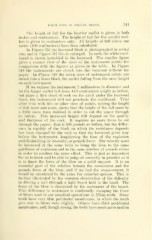Page 511 - My FlipBook
P. 511
FORCE USED IN FILLIKCJ TEKTII. 241
The lu'iglit of fall for the heavier mallet is given in both
inches and centimeters. The height of fall for the smaller mal-
lets is given in centimeters only. All heights of fall above one
meter (100 centimeters) have been calculated.
In Figure 316 the boxwood block is photographed in actual
size, and in Figure 317 this is enlarged. In each, the white card-
board is shown imbedded in the boxwood. The smaller figure
gives a correct view of the sizes of the instrument points for
comparison with the figures as given in the table. In Figure
318 the instruments are struck into the Ijoxwood without the
paper. In Figure 319 the seven sizes of instrument points are
struck into a brass block, the mallet falling from the same height
on each instrument.
If we replace the instrument 2 millimeters in diameter and
let the larger mallet fall from 44.8 centimeters height as before,
but place a thin sheet of cork on the anvil under the boxwood
block, the instrument will not penetrate the cardboard. Trial
after trial with this or other sizes of i^oints, raising the height
of fall more and more, shows that the height of the fall must be
a little more than doubled in order to cut the paper through
as before. This increased height will depend on the quality
and thickness of the cork. It requires no more force to cut
through the paper; that is 160 pounds as before, but the differ-
ence in rigidity of the block on which the resistance depends
has been changed by the cork so that the boxwood gives way
before the instrument, lengthening the time of the explosion
and diminishing its intensity, or pounds force. The velocitj' must
be increased in the same ratio to bring the blow to the same
quickness of explosion and to the same number of pounds stress
in order to produce the same effect. This is just as important
for us to know and be able to judge of correctly in practice as it
is to know the force of the blow on a solid support. It is an
essential part of the relation beween the momentum and the
pounds force of the blow, and if we had the measurement, it
would be calculated by the rules for retarded motion. This is
further illustrated by the common obsei'vation of the difficulty
in driving a nail through a light board held in the hand. The
force of the blow is dissipated by the movement of the board.
This difference in resistance is continually changing the force
of blows used in our practical operations in filling teeth. Some
teeth have very thin peridental membranes, in which the teeth
give way to blows very slightly. Others have thick peridental
membranes, and, though strong, the teeth have much more motion


